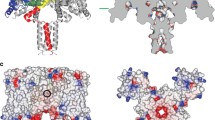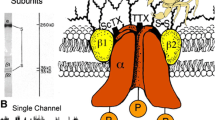Purpose
To investigate the response to general anesthetics of different sodium-channel subtypes, we examined the effects of pentobarbital, a close thiopental analogue, on single sodium channels from human skeletal muscle and compared them to existing data from human brain and human ventricular muscle channels.
Methods
Sodium channels from a preparation of human skeletal muscle were incorporated into planar lipid bilayers, and the steady-state behavior of single sodium channels and their response to pentobarbital was examined in the presence of batrachotoxin, a sodium-channel activator. Single-channel currents were recorded before and after the addition of pentobarbital (0.34–1.34 mM).
Results
In symmetrical 500 mM NaCl, human skeletal muscle sodium channels had an averaged single-channel conductance of 21.0 ± 0.6 pS, and the channel fractional open time was 0.96 ± 0.04. The activation midpoint potential was −96.2 ± 1.6 mV. Extracellular tetrodotoxin blocked the channel with a half-maximal concentration (k1/2) of 60 nM at 0 mV. Pentobarbital reduced the time-averaged conductance of single skeletal muscle sodium channels in a concentration-dependent manner (inhibitory concentration 50% [IC50] = 0.66 mM). The steady-state activation was shifted to more hyperpolarized potentials (−16.7 mV at 0.67 mM pentobarbital).
Conclusion
In the planar lipid bilayer system, skeletal muscle sodium channels have some electrophysiological properties that are significantly different compared with those of sodium channels from cardiac or from central nervous tissue. In contrast to the control data, these different human sodium channel subtypes showed the same qualitative and quantitative response to the general anesthetic pentobarbital. The implication of these effects for overall anesthesia will depend on the role the individual channels play within their neuronal networks, but suppression of both central nervous system and peripheral sodium channels may add to general anesthetic effects.
Similar content being viewed by others
Author information
Authors and Affiliations
About this article
Cite this article
Wartenberg, H., Urban, B. Single sodium channels from human skeletal muscle in planar lipid bilayers: characterization and response to pentobarbital. J Anesth 18, 100–106 (2004). https://doi.org/10.1007/s00540-004-0227-7
Received:
Accepted:
Issue Date:
DOI: https://doi.org/10.1007/s00540-004-0227-7




